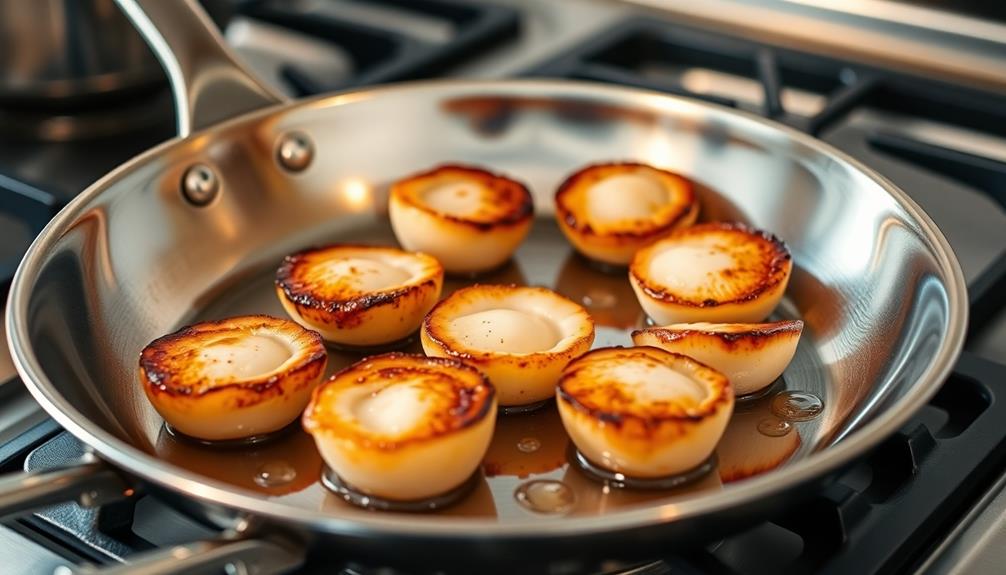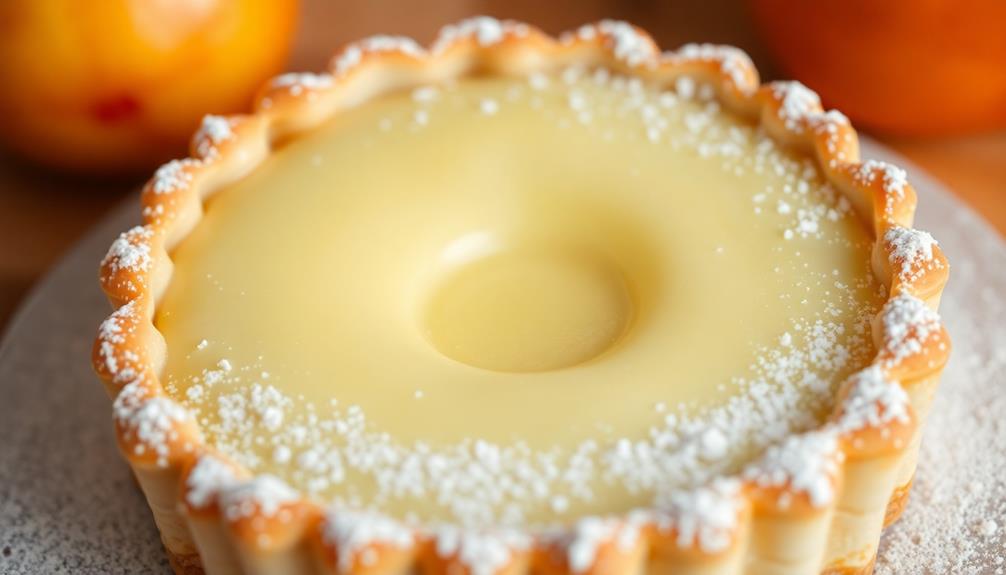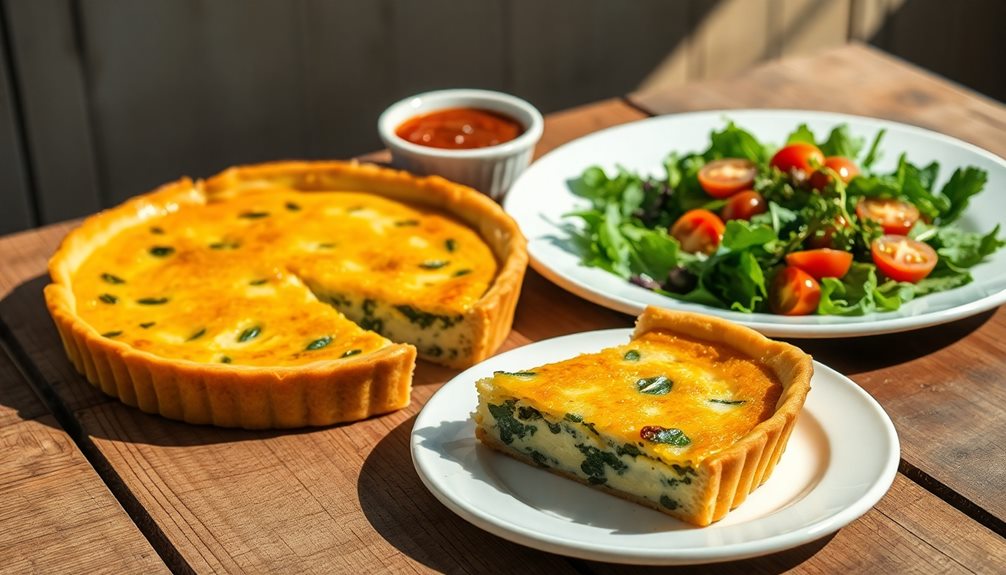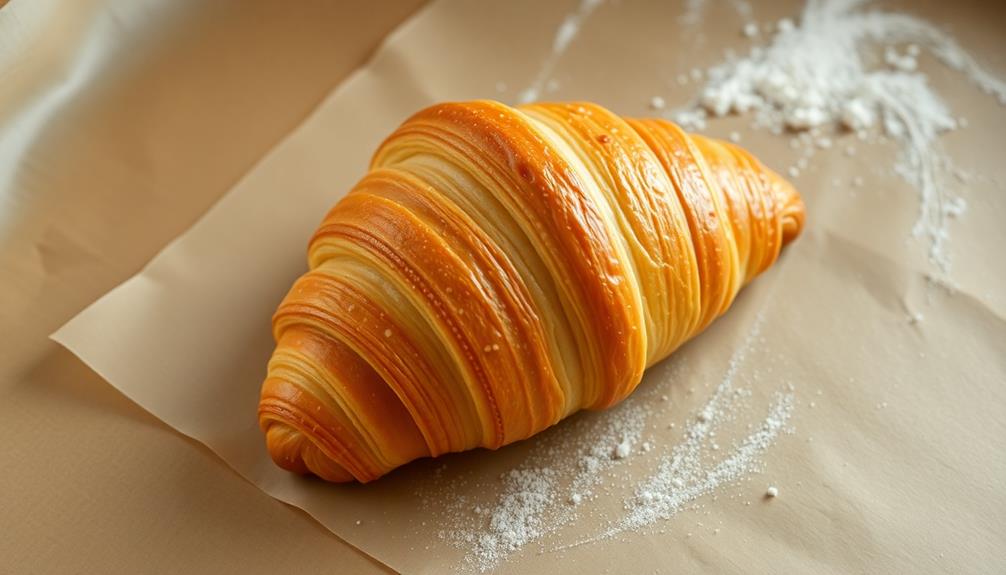Unlock the secrets to creating French macarons, the delicate cookies that have captivated the world! Tracing back to the 16th century, these sweet treats were once favored by French nobility. Today, they're a beloved part of French culture and a symbol of culinary excellence. Mastering the art of macarons requires precision, but the rewards are well worth it – light, airy meringue shells, and creamy fillings in a rainbow of flavors. Follow the recipe essentials, from sifting the almond flour to carefully piping the batter. With practice, you'll be baking up perfect macarons that will impress your family and friends. There's more to discover about these delightful cookies!
Key Takeaways
- The origins of French macarons can be traced back to the 16th century, when they were introduced to France by Catherine de' Medici.
- Proper preparation of the ingredients, including precisely beating the egg whites and folding the meringue into the almond mixture, is crucial for achieving the desired light, airy texture.
- Baking temperature, resting period, and careful piping of the batter are essential steps in the macaron-making process to ensure the development of the characteristic "foot" and smooth, flat tops.
- Troubleshooting and learning from early baking attempts are important for mastering the techniques and achieving consistent, successful macaron results.
- The art of making French macarons combines science and creativity, providing a rewarding culinary experience and a sense of accomplishment for bakers.
History
The origins of the French macaron can be traced back to the early 16th century, when Italian chef Catherine de' Medici introduced the delicate almond-based cookie to France during her marriage to Henry II.
These light, airy treats quickly gained popularity among the French nobility. Over the centuries, the macaron evolved, with the addition of various fillings and flavors. The delicate texture and beautiful colors of macarons made them a popular choice for special occasions and fancy banquets. Today, they are enjoyed by people all over the world, with many different variations and flavors to choose from. Despite their evolution, macarons still hold a special place in the hearts of many, much like the traditional Greek pastry, baklava, does for those who appreciate its rich history and delicious taste.
By the 19th century, the macaron had become a beloved part of French culture, with Parisian pâtisseries vying to create the most exquisite and unique versions.
Today, the French macaron is celebrated worldwide as a symbol of French culinary excellence. Its delicate, yet complex texture and flavor profile make it a true delight for the senses.
Whether you enjoy a classic almond macaron or a more adventurous flavor, the history and craftsmanship behind these charming cookies is sure to impress.
Recipe
French Macarons are delicate, meringue-based cookies that are beloved for their light and airy texture, as well as their vibrant colors and flavors. These delicate treats are a true French classic and can be an impressive addition to any dessert table.
To create the perfect French Macarons, it's important to follow the recipe precisely and pay close attention to the details. The success of these cookies lies in the careful preparation of the batter and the gentle handling during the baking process.
Ingredients:
- 120g almond flour
- 200g powdered sugar
- 100g egg whites (approximately 3 large eggs)
- 50g granulated sugar
- Food coloring (optional)
- Filling of your choice (e.g., buttercream, ganache, jam)
Instructions:
Preheat your oven to 300°F (150°C). Line two baking sheets with parchment paper or silicone baking mats. In a food processor, pulse the almond flour and powdered sugar together until well combined. Sift the mixture to remove any large pieces.
In a clean, dry bowl, whisk the egg whites until they begin to foam. Gradually add the granulated sugar, whisking until the meringue forms stiff, glossy peaks. Gently fold the almond flour mixture into the meringue in three batches, being careful not to overmix. If desired, add a few drops of food coloring and fold it in.
Transfer the batter to a piping bag fitted with a round tip and pipe small, evenly-sized rounds onto the prepared baking sheets, leaving about 1-inch of space between each macaron. Tap the baking sheets firmly on the counter to release any air bubbles. Allow the macarons to rest at room temperature for 30 minutes to 1 hour, or until a skin forms on the surface.
Bake for 12-15 minutes, rotating the baking sheets halfway through, until the macarons are firm and have developed a "foot" at the base. Allow the macarons to cool completely on the baking sheets before removing them.
When baking French Macarons, it's essential to be patient and follow the steps precisely. Overmixing the batter or overbaking the cookies can lead to cracks or flat, poorly-shaped macarons.
Additionally, allowing the piped batter to rest and form a skin before baking is crucial for achieving the desired smooth, flat tops. With practice and attention to detail, you'll be able to create beautifully consistent French Macarons that will impress your friends and family.
Cooking Steps
First, you'll sift the almond flour and confectioners' sugar to get a smooth, even mixture.
Next, you'll beat the egg whites until they're stiff and glossy.
Then, you'll gently fold the meringue into the almond mixture to create a smooth, flowing batter.
Time to pipe the batter onto a baking sheet and bake those delicious macarons!
Step 1. Sift Almond Flour and Confectioners' Sugar
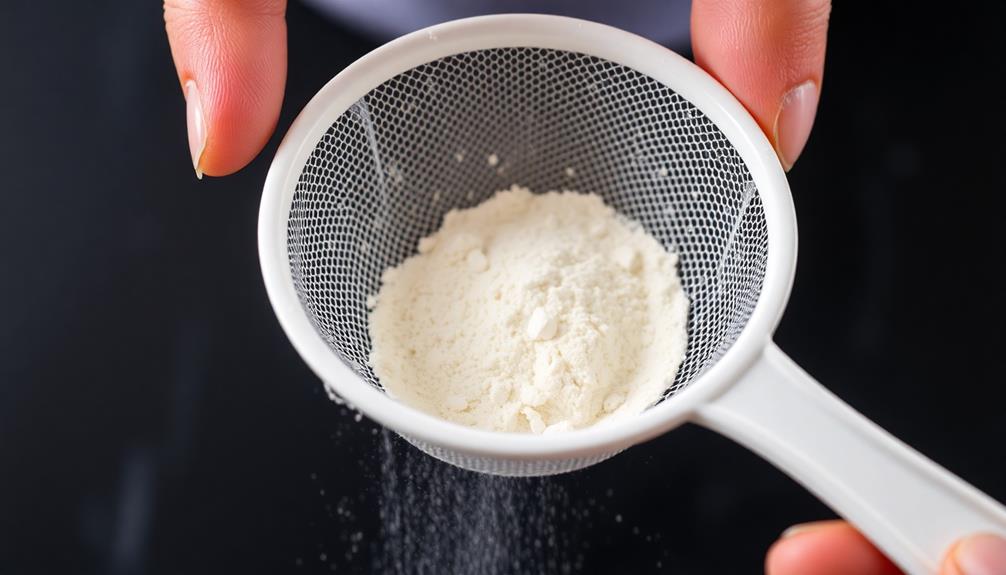
Sifting the almond flour and confectioners' sugar is a crucial step in making delicate French macarons. This process helps to ensure a smooth, consistent texture in the batter. For an even better experience, consider using high-quality butter, such as grass-fed butter, which can enhance the flavor of your macarons.
Start by gathering your ingredients – you'll need a fine-mesh sieve and both almond flour and confectioners' sugar. Gently pour the almond flour into the sieve and shake it back and forth to allow the fine flour to fall through. This removes any larger pieces that could create bumps in your macaron shells.
Next, sift the confectioners' sugar in the same way. Take your time with this step, as properly sifting the dry ingredients will prevent any grittiness in the final cookies. Once you've sifted both the almond flour and sugar, combine them in a bowl and give them a gentle mix.
This well-aerated mixture will be the foundation for your light, airy macarons. Pay close attention to this step, and you'll be on your way to macaron perfection!
Step 2. Beat Egg Whites to Stiff Peaks
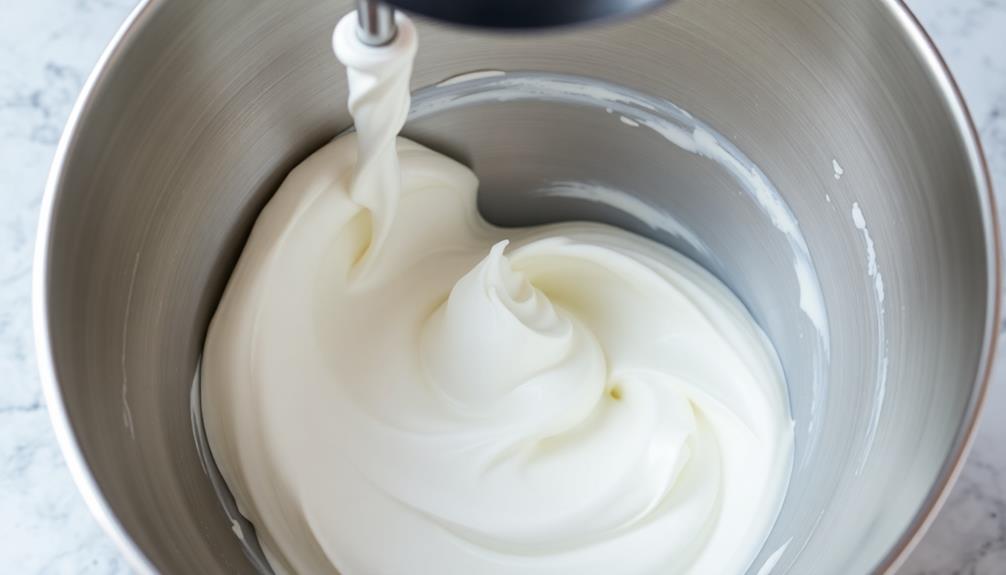
Next, how do you go about beating the egg whites to stiff peaks? It's an essential step in making French macarons!
First, make sure your mixing bowl and beaters are completely clean and dry. This helps the egg whites whip up nice and fluffy.
Add the egg whites and start beating on medium speed. As the whites start to foam, gradually increase the speed to high.
Keep whipping until the whites form stiff, shiny peaks that hold their shape when you lift the beaters. This might take 5-8 minutes, so be patient!
The egg whites should be thick and glossy, not dry and crumbly. Once you've reached the perfect stiff peak stage, you're ready for the next step.
Just be careful not to overbeat them, or the macaron batter won't turn out quite right.
With the right technique, you'll have beautifully whipped egg whites that will help your macarons bake up light and airy.
Step 3. Fold Meringue Into Almond Mixture

After beating the egg whites to stiff peaks, you'll need to gently fold the meringue into the almond mixture. This step requires a delicate touch to maintain the light and airy texture you've achieved.
Start by adding a spoonful of the meringue to the almond mixture and gently folding it in using a rubber spatula. Work in a circular motion, cutting through the center and lifting the batter up and over.
Repeat this process, gradually incorporating more meringue until the mixture is fully combined. Be careful not to overmix, as this can deflate the meringue and result in a dense, heavy macaron.
The batter should have a smooth, glossy appearance and fall from the spatula in thick ribbons. Once the meringue is fully incorporated, your macaron batter is ready to be piped onto the baking sheets.
Proper folding technique is key to achieving the perfect macaron texture, so take your time and enjoy this satisfying step in the process.
Step 4. Pipe Batter Onto Baking Sheet
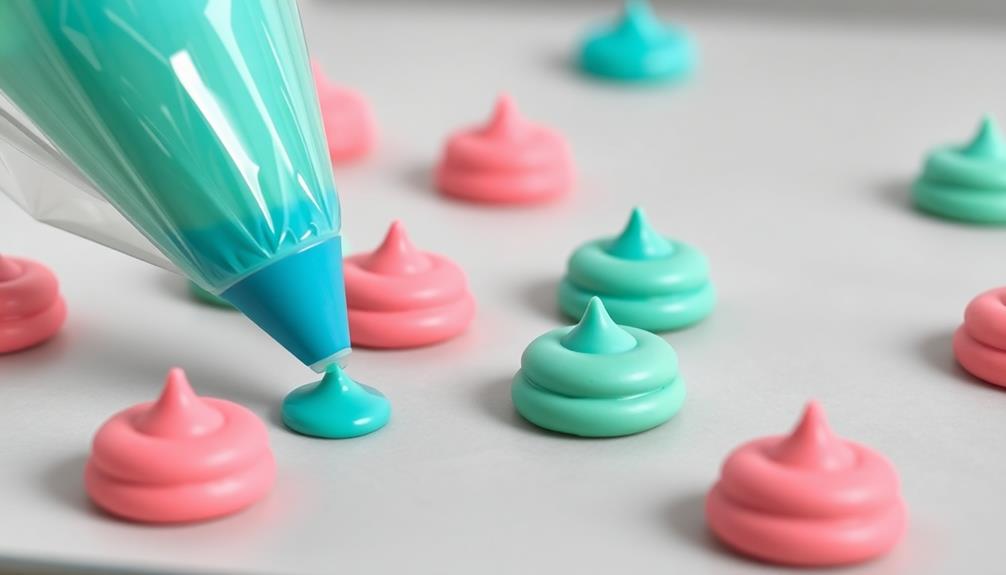
With your meringue now gently folded into the almond mixture, it's time to transfer the macaron batter onto the prepared baking sheets.
Grab a piping bag and snip off the tip, creating a small opening. Carefully scoop the batter into the piping bag, being mindful not to overfill it. Position the piping bag perpendicular to the baking sheet, then squeeze the bag gently to pipe small, evenly-sized rounds of batter. Space the rounds about an inch apart to allow for expansion during baking.
Once you've piped all the batter, gently tap the baking sheets on the counter a few times. This helps the batter settle and releases any air bubbles.
Now, let the piped macarons rest for 30 minutes. This resting period is crucial, as it allows the surface of the batter to dry and form a slight skin. This skin is what'll help the macarons develop their characteristic "feet" during baking.
After the rest, your macarons are ready to be baked to perfection!
Step 5. Bake Macarons in Oven
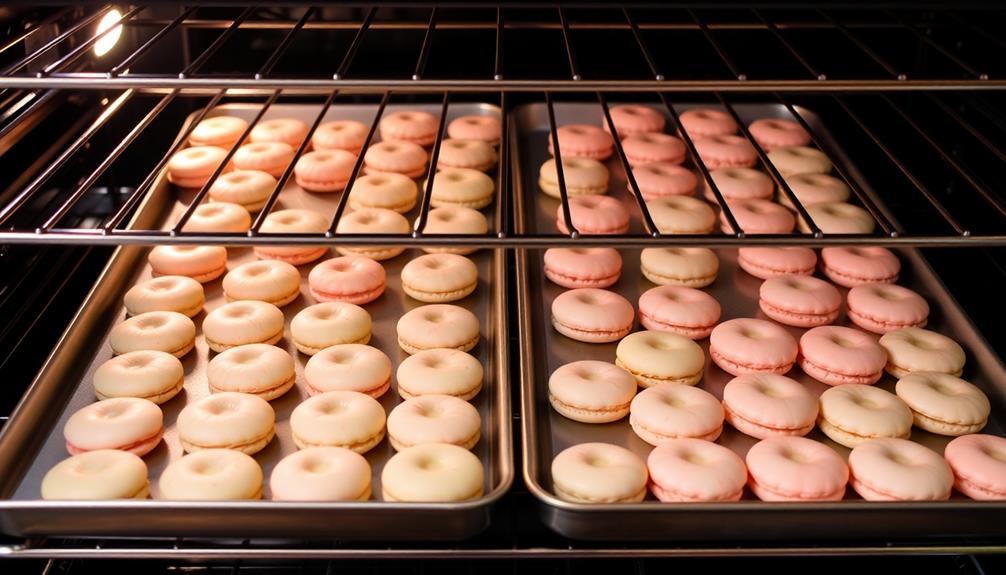
Preheat your oven to 300°F (150°C).
Carefully place the baking sheets with the piped batter into the preheated oven. Bake the macarons for 12 to 15 minutes, keeping a close eye on them. They're ready when you can gently lift the tops off the baking sheet without the whole cookie coming up. The macarons should develop a smooth, shiny "skin" on top.
Once baked, remove the sheets from the oven and let the macarons cool completely on the baking sheets. This step is crucial, as the macarons need to fully set before you can gently peel them off. If you try to remove them too soon, they may crack or break apart.
After the macarons have cooled, carefully peel them off the baking sheets. They should release easily if they're properly baked.
Congratulations! You've now successfully baked a batch of delicate and beautiful French macarons.
Final Thoughts
Ultimately, mastering the art of French macarons requires patience, precision, and a keen eye for detail.
While these delicate cookies may seem intimidating at first, the joy of creating and sharing them is truly rewarding. Additionally, mastering the art of royal icing cookie decorating techniques opens up a world of creative possibilities. With practice, you can achieve intricate designs and stunning patterns that will impress your friends and family. The satisfaction of seeing your homemade cookies turn into edible works of art is worth the effort.
As you've learned, each step in the process – from properly beating the egg whites to piping the batter and baking to perfection – is crucial.
Don't be discouraged if your first few batches don't turn out quite right. It takes practice to develop the right touch.
Frequently Asked Questions
How Long Do French Macarons Last?
Properly stored, your French macarons can last up to 5 days at room temperature. For longer shelf life, refrigerate them for up to a week or freeze for 2-3 months. Enjoy the delicate, melt-in-your-mouth texture while they're fresh!
Can I Make Macarons Ahead of Time?
You can make macarons ahead of time, but they won't last as long as freshly baked ones. They're best consumed within a few days, so plan to make them close to when you need them.
What Is the Best Way to Store Macarons?
The best way to store macarons is in an airtight container in the refrigerator. This will keep them fresh for up to 5 days. You can also freeze them for up to 2 months.
Can I Freeze Macaron Batter or Cookies?
You can freeze macaron batter or fully baked cookies. Freeze batter in an airtight container for up to 3 months. Freeze baked cookies in a single layer on a baking sheet, then transfer to an airtight container for up to 2 months.
How Do I Know When My Macarons Are Done?
To know when your macarons are done, look for a firm, smooth shell and a slight rise in the center. The edges should be lightly browned, and the feet should be well-defined. Give them a gentle tap – they should be set but not overly firm.

